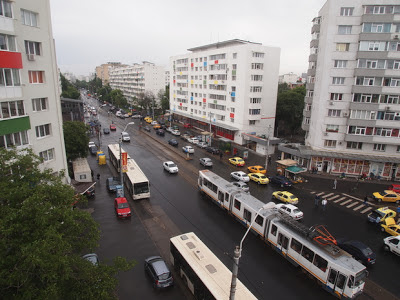The greenest way of getting around may be walking, or riding a bicycle. Taking mass transit is generally very green because a bus or train can carry more people per square mile than can individually driven cars, the vehicles are reused by multiple passengers, better fuel efficiency per passenger mile, and so forth. The first step I want to cover in this series of blog posts is to look at a high traffic multi-modal transit hub as seen from the balcony of an apartment where I stayed for a few days.
This post is part of a series stemming from a trip I’ve taken to an Eastern European country. These posts are looking at a society where walkable transit-friendly cities and ultra fresh food is the norm. To view the whole series see: The benefits of walkable communities and local food
This first set of shots is an overview of a major road intersection. My girlfriend was smart enough to buy an apartment right at this intersection. There’s a lot of stuff in this picture … several large apartment buildings, two major roads, a subway (Metro) station, a light rail line, a taxi stand, bus stops, pedestrians, lots of cars, and shops of all sorts along the ground floor.
The city has an extensive Metro (subway) system. One of the stops is right here, in the center of the 3rd picture. The entrance to the station is the green roofed building, you take stairs downward to the actual station and the trains run underground. There is an elevator available but when we tried to use it the thing appeared to be broken. In general this country does not have much of an attitude for accommodating handicapped people.
The city has an extensive light rail system (known locally as Tranvai). A tramvai line runs right in front of the apartment building, and you see the train in several of the pictures.
The city has an extensive bus system, and there are several bus lines with stops shown in this picture.
There is an extensive system of privately operated buses, and you see several of those buses parked here. Also shown is a large taxi stand next to the Metro station.
Cars are growing in popularity, especially because there is housing construction occurring on the outskirts outside the reach of the mass transit. At certain times of day the streets are clogged with traffic, and it can take an hour to drive a few kilometers that would normally require 15 minutes.
Another feature throughout the city is an extensive infrastructure of shops on the first floor of the buildings. We see here a series of food shops – a bread shop, a general food store, a pastry shop, and a Shaorma fast food joint.
What we don’t see here is that across the street are other shops selling bread, clothing, food, drinks, pastries, books, and everything else. On the other side of the intersection there’s a whole series of bank offices, one after another. A little further away is a farmers market that’s open every day selling fresh food of all kinds.
This intersection is not unique around the city. There are plenty of spots around the city with this many shops integrated with the neighborhoods.
Each of the buildings seen here are communist-era apartment blocks (this country freed itself from communist rule about 25 years ago). These are still the primary housing not just in this city, but across the country.
Whatever bad you might say about these apartment buildings, they mean the population density is pretty high.
The high population density means the streets and sidewalks are teeming with activity. That in turn supports the existence of all these shops and transit choices you see here.
Those of us who live in American Suburbia don’t have anything like this. We’re lucky to have a small shop a couple weeks away selling crap junk food. The food shops you see here sell good quality fresh food. Most of the bread and pastry shops shown here bake on site, in the shop, or else nearby.
The typical American is driving to get their daily food needs. For the people who live in the buildings pictured here, a short walk of a couple hundred yards gets them to a huge variety of food shops selling nice fresh food.
- Highway design could decrease death and injury risk, if “we” chose smarter designs - March 28, 2015
- GM really did trademark “range anxiety”, only later to abandon that mark - March 25, 2015
- US Government releases new regulations on hydraulic fracturing, that some call “toothless” - March 20, 2015
- Tesla Motors magic pill to solve range anxiety doesn’t quite instill range confidence - March 19, 2015
- Update on Galena IL oil train – 21 cars involved, which were the supposedly safer CP1232 design - March 7, 2015
- Another oil bomb train – why are they shipping crude oil by train? – Symptoms of fossil fuel addiction - March 6, 2015
- Chevron relinquishes fracking in Romania, as part of broader pull-out from Eastern European fracking operations - February 22, 2015
- Answer anti- electric car articles with truth and pride – truth outshines all distortions - February 19, 2015
- Apple taking big risk on developing a car? Please, Apple, don’t go there! - February 16, 2015
- Toyota, Nissan, Honda working on Japanese fuel cell infrastructure for Japanese government - February 12, 2015





























